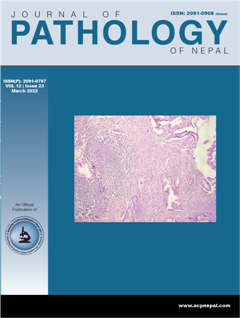Histopathological findings on endometrial biopsy in a tertiary care center of Nepal: a retrospective cross-sectional study
DOI:
https://doi.org/10.3126/jpn.v12i1.38595Keywords:
Abnormal uterine bleeding; Endometrial biopsy; Endometrial hyperplasiaAbstract
Introduction: Abnormal uterine bleeding is the most common presentation in endometrial pathology and endometrial biopsy is the investigation of choice. This study aimed to describe the histological findings of patients who underwent endometrial biopsy to estimate the most common endometrial diseases in Nepali women.
Materials and methods: This retrospective cross-sectional study was conducted using hospital records, and included females who underwent endometrial biopsy at a tertiary level hospital from 1 April 2018 to 31 March 2020. Histopathological findings were categorized into eight groups, and patients were divided into three age groups to obtain the relative occurrence of each type of disease at different ages
Results:342 female patients were included in the study, among which 97 were pregnancy-related and 245 were non-pregnancy-related. The mean age of the patients was 41.63 years (± 11.45 years). In 28 cases (8.2%) of the 342 total cases, the endometrial biopsy sample was deemed inadequate. Among the non-pregnancy-related cases, normal physiological changes were the most common reported finding (n=93, 38.0%), followed by abnormal physiologic changes (n=68, 27.8%). Premalignant conditions (n=15, 6.1%) and malignancy (n=5, 2.0%) were less common.
Conclusions: Normal physiological changes and disordered proliferative endometrium are the most common findings in an endometrial biopsy. Endometrial hyperplasia and malignancy are less common, and usually found in women more than 40 years in age.
Downloads
Downloads
Published
How to Cite
Issue
Section
License
Copyright (c) 2021 Amar Narayan Shrestha, Barun Babu Aryal, Anurag Adhikari, Ayusha Poudel, Ramhari Rouniyar, Bidur Khatiwada

This work is licensed under a Creative Commons Attribution 4.0 International License.
This license enables reusers to distribute, remix, adapt, and build upon the material in any medium or format, so long as attribution is given to the creator. The license allows for commercial use.




